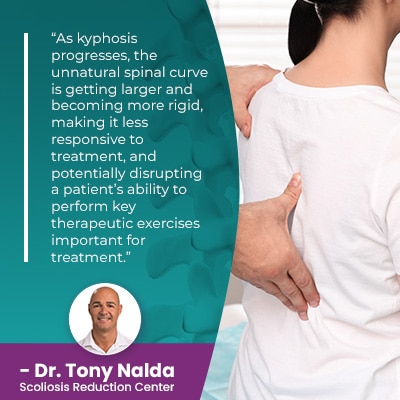Kyphosis Surgery: Costs, Recovery Times, and Alternatives

There are two main treatment approaches for a variety of spinal conditions, kyphosis included; traditional treatment tends to funnel patients towards spinal fusion, while a modern conservative approach offers a non-surgical treatment alternative. Conservative treatment acts proactively in an effort to prevent progression and reduce the curve on a structural level.
Kyphosis surgery is a type of spinal fusion; it’s a costly and invasive procedure that can affect the spine’s natural function and strength, and as there are risks involved, it should be considered carefully. Many cases of kyphosis don’t require surgery.
The spine’s natural curves are key to maintaining optimal spinal health and function, so let’s explore the different types of healthy spinal curves.
Table of Contents
Healthy Spinal Curves
The spine’s natural and healthy curves make it stronger, more flexible, and better able to handle mechanical stress incurred during activity, like a coiled spring.
When a healthy spine is viewed from either side, it will have a soft ‘S’ shape, and when viewed from the front and/or back, it will appear straight.
The spine is curved at each of its main sections: cervical spine (neck), thoracic spine (middle/upper back), and the lumbar spine (lower back).
The spine’s vertebrae (bones) are stacked on top of one another in a straight and neutral alignment, and adjacent vertebrae are separated by an intervertebral disc, and the spinal discs give the spine structure, flexibility, help prevent friction, and act as the spine’s shock absorbers; they are generally the first spinal structures to start to degenerate.
In fact, degenerative disc disease can be the root cause of a number of spinal conditions, particularly those that involve a loss of the spine’s healthy curves and spinal degeneration.
There are two main curvature types: kyphosis and lordosis. Kyphosis refers to the spine’s backward-bending curve in the thoracic spinal section, while lordosis refers to the cervical and lumbar spinal section’s forward-bending curves.
While there is a natural range of curvature-sizes, measured in degrees, if a person’s curvature-degree becomes excessive, this can cause problems as the spine’s overall biomechanics are disrupted.
What is Hyperkyphosis?
A healthy range of thoracic kyphosis would fall between 20 and 40 degrees, and if a person’s curvature degree is 50+ degrees, this is commonly diagnosed as hyperkyphosis, and this means that the middle/upper back has developed an excessive kyphotic curve.
When the spine loses one of its healthy curves, it often responds by putting in an unhealthy curve, and the health of each spinal section is dependent upon the health of the others.
Hyperkyphosis can cause a number of symptoms, of which the main one is postural deviation that causes a roundback appearance; this is because the excessive kyphosis causes the shoulders and upper back to round-forward excessively.
Hyperkyphosis Symptoms
Each case of hyperkyphosis is unique, and symptoms are shaped by a condition’s underlying cause, severity, and the degree of nerve involvement.
In addition to causing a roundback appearance, some common symptoms of hyperkyphosis include:
- Uneven shoulders
- The head being excessively bent forward
- Shoulder blade asymmetry
- A noticeable arch on the upper back
- Tight and sore leg muscles
- Tingling sensations and/or numbness caused by nerve compression
So for those experiencing any of the aforementioned symptoms, the way those symptoms are responded to with treatment is important, so let’s move onto kyphosis treatment options: both surgical and non-surgical.
Kyphosis Surgery
Kyphosis surgery is a type of spinal fusion, and this involves fusing the most-tilted vertebrae of a curve into one solid bone to eliminate movement (progression) in the area.
In most cases, rods are attached to the spine with screws to hold it in place, and hardware attached is permanent.
A spine that’s fused is fused for life; if surgery is unsuccessful and/or complications develop, the only recourse is more surgery, and surgical risks increase with each subsequent procedure, and with increasing patient age.
Recovery times will be case-specific and depend on a number of variables such as patient age, condition type, severity, the number of vertebrae fused, and whether or not there were any complications during the procedure.
Potential complications associated with the procedure itself can include excessive blood loss, infection, nerve damage, and adverse reactions to hardware used.
The financial cost of spinal fusion is also equally variable and can fall within a range of $37,000 to $175,000, and, remember, the non-monetary costs of a surgical response should also be considered.
The issue with this type of surgical response is that, in some cases, patients find that the fused section of the spine is excessively rigid and inflexible, and that can reduce a person’s range of motion and impact overall quality of life.
If the spine is experiencing a reduced range of motion due to surgery, it can make it difficult to participate in once-loved activities, and in addition, a fused spine is more vulnerable to injury, and that knowledge can cause patients to become fearful of trying new things.
In addition, some patients also report increasing levels of back pain post-spinal fusion.
While some patients still maintain enough flexibility above and below the fused area to not experience a noticeable difference in spinal flexibility and range of motion, many do, so it is a potential outcome.
The goal of kyphosis surgery isn’t to achieve corrective results, but to stop the condition from getting worse: two very different things.
 While traditional treatment offers a surgical response to excessive kyphosis, conservative treatment offers a non-surgical response that works towards achieving corrective results.
While traditional treatment offers a surgical response to excessive kyphosis, conservative treatment offers a non-surgical response that works towards achieving corrective results.
Conservative Kyphosis Treatment
Here at the Scoliosis Reduction Center, I treat my kyphosis patients with a proactive conservative treatment approach with the goal of correcting kyphosis.
When kyphosis is structural, as is the case with Scheuermann’s kyphosis, this means the condition involves a structural abnormality within the spine itself, and treatment has to, first and foremost, impact it on a structural level.
Condition-specific chiropractic care uses a series of techniques and manual adjustments to work towards repositioning the curve’s most-tilted vertebrae back into alignment with the rest of the spine, and this restores as much of the spine’s healthy curves as possible.
 As kyphosis progresses, the unnatural spinal curve is getting larger and becoming more rigid, making it less responsive to treatment, and potentially disrupting a patient’s ability to perform key therapeutic exercises important for treatment.
As kyphosis progresses, the unnatural spinal curve is getting larger and becoming more rigid, making it less responsive to treatment, and potentially disrupting a patient’s ability to perform key therapeutic exercises important for treatment.
Conditions like Scheuermann’s kyphosis have it in their nature to get worse over time, so there’s no benefit to delaying treatment, particularly for those wanting to avoid progression and the need for more invasive surgical treatment in the future.
Once I have impacted a condition structurally, I can shift the focus to increasing core strength so the spine is surrounded by strong muscles that can optimally support it, and this can be worked towards through physical therapy, which can also help with postural remodeling, and certain condition-specific exercises can activate specific areas of the brain for improved brain-body communication.
Kyphosis is most commonly diagnosed in adolescents, and corrective bracing can be particularly effective on growing spines and help achieve corrective results by pushing the spine into a corrective position.
If treatment success has been reached, the final phase is ongoing so long-term treatment results can be sustained, and this involves establishing a home-rehabilitation program using custom-prescribed exercises to further stabilize and heal the spine.
Conclusion
While kyphosis surgery can help straighten an unnaturally-curved spine, the way it does so by fusing vertebrae together and holding them in place through artificial means is contrary to the spine’s movement-based design.
A spine with multiple vertebrae that are fused together also means the removal of the intervertebral discs that sit between adjacent vertebrae, which is also contrary to the spine’s natural design.
While traditional kyphosis treatment funnels patients towards spinal fusion surgery, modern conservative treatment opts for a non-surgical response that works towards actually correcting excessive kyphosis on a structural level.
Here at the Center, I customize treatment plans based on key patient/condition variables such as patient age, condition type, severity, and experienced symptoms.
By integrating multiple different treatment modalities into a treatment plan, I can monitor how the spine is responding to treatment and apportion the disciplines accordingly for the best potential results.
When it comes to spinal conditions like kyphosis that tend to get worse over time, it’s not just when a diagnosis is reached that affects treatment outcome, but also when treatment is started.
I start kyphosis treatment as close to the time of diagnosis as possible; while there are never treatment guarantees, early detection and intervention is associated with higher rates of treatment efficacy.
Dr. Tony Nalda
DOCTOR OF CHIROPRACTIC
After receiving an undergraduate degree in psychology and his Doctorate of Chiropractic from Life University, Dr. Nalda settled in Celebration, Florida and proceeded to build one of Central Florida’s most successful chiropractic clinics.
His experience with patients suffering from scoliosis, and the confusion and frustration they faced, led him to seek a specialty in scoliosis care. In 2006 he completed his Intensive Care Certification from CLEAR Institute, a leading scoliosis educational and certification center.
About Dr. Tony Nalda
 Ready to explore scoliosis treatment? Contact Us Now
Ready to explore scoliosis treatment? Contact Us Now





